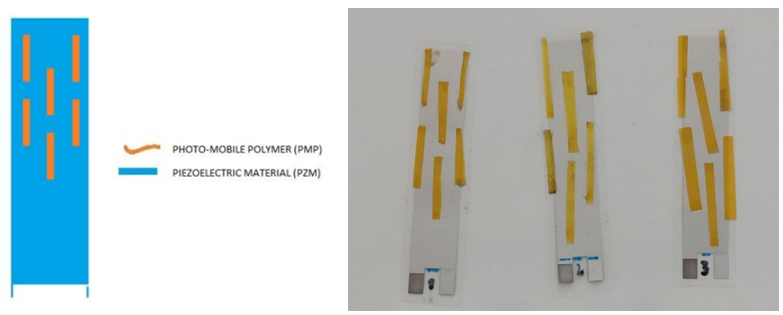Azobenzene-based photo-mobile polymer (PMP) samples were mechanically coupled with foils of commercial piezoelectric material (PZM) (Sensor DT Series Piezo Film vibration, by TE Connectivity) (Figure 1). The obtained assembly was placed under a solar simulator. The solar simulator used a short arc xenon lamp as a light source with an AM1.5 filter to mimic the absorption spectrum of earth’s atmosphere. This setup is commonly used for testing solar cells (at a power density of 1 000 W/m²).

Figure 1: Schematic representation of the PMP-PZM connection system used during the experiment on left and actual assembly on right
The movement of the PMPs can be attributed to a narrow spectrum of light near the UV range while heat or light outside of that narrow band can prove detrimental to the motion. While it was shown that any optical filters that removed the UV component led to completely stopping the PMP motion, the system was capable of operating in direct sunlight and generated measurable energy on the load.
While the system was suspended under the solar simulator, the light was turned on and off in 30 second intervals. The amplitude reached a maximum of 4.2 V and decayed exponentially with an RC time constant of 5.2 while a load of 64 MOhm was connected to the terminals of the PZM (Figure 2).

Figure 2: Steady state operation of PMP-PZM system. Measured on 64 MOhm load via buffer amplifier and ideal rectifier (hence rectified halves of the plot).
Peak voltage of over 4 V was achieved and discharged an average of 710 nJ over a 50 s period. This result could be significantly improved but was limited by the mechanical capabilities of the shutter.
For more information, please have a look at the article untitled “Photo-mobile polymers in energy harvesting applications under simulated solar light”, written by W. Andrysiewicz, D. Wojcieszczaka, R. Sochaa, D. Sagnelli, A. D’Avinoamali and L. Petti, for the SPIE Conference – https://doi.org/10.1117/12.2666931


